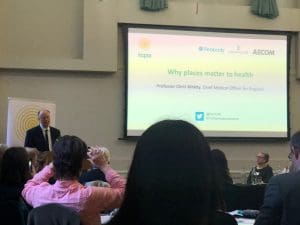A turning point in leveraging the power of planning to deliver healthy urban environments?
Michael Chang

The TCPA’s 2022 annual conference was on the theme of “Unpicking ‘levelling up’: what does it mean for place-making?”. It took place on the 24th November at the Regent’s University in London. Of particular interest to the TRUUD project was the final session in the afternoon on Health and Wellbeing to focus on the two health and wellbeing missions of the Government’s Levelling Up White Paper: to narrow the gap in healthy life expectancy and improve wellbeing in every area of the UK.
The keynote speaker of this session was the Chief Medical Officer for England, Professor Chris Whitty. In his speech he understood and appreciated that unhealthy environments will lead to unhealthy outcomes. He highlighted several factors in relation to what he sees as current public health priorities and the contribution of planning and planners to public health.
Firstly, he commended the work being done to improve air quality over the years and expects air quality to continue to improve in the future. However he mentioned a gap in addressing indoor air pollution of spaces in public settings such as schools and libraries, and called for more to be done in the urban environment on indoor air quality.
Looking forward he highlighted the issue of the built environment’s response to changing demographics with an ageing population. He stated with concentrations of older people in more rural areas (a topic he based his last CMO’s annual report on), and housing has not been designed to cater to their needs.
Obesity will continue to be a priority with issues around calories/ nutrition and lack of exercise. With data showing direct relationship between obesity and ill health, and concentration of obesogenic environments in certain parts of the country and in areas of deprivation is a serious problem.
He also raised the issue of the availability of data needing to be more granular to identify those areas and communities that may be averaged out when looking at maps. There is more impact on health if work is better concentrated in these areas.
He concluded his presentation by acknowledging and praising the planning profession, and suggested that more has been done for public health by proper planning, proper engineering, proper built environments, than other interventions apart from vaccinations. Healthy urban environments will have the biggest impact on health in the long run.
My final reflection on Professor Whitty’s presentation and his responses during the panel discussion was that he clearly understood and recognised the contribution of planning to tackling the nation’s health. His engagement with the planning profession demonstrated his desire to show planners the impact of their actions can have, and coming from a respectable public health voice, his praise of the profession should not be under-estimated. This means the work being done across the TRUUD project is more important than ever if the outputs can help planners bring forward more healthy urban environments
